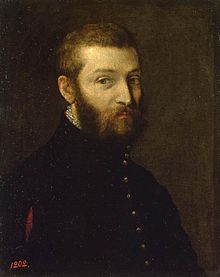 Venice and all things Venetian
are the province of History Girl Michelle Lovric but today I’m venturing onto
her territory. The topic came to me by a rather strange route involving my sluggish
brain and the jungle of Russian grammar rules relating to dates. My tutor set me
some homework: choose an artist and write an essay on him incorporating all the
significant dates in his life. Not as self-evidently useful as learning, say,
how to order vodka and blini, but nevertheless a good exercise and, Russian grammar aside,
it gave me a delightful insight into the personality of Paolo Veronese.
Venice and all things Venetian
are the province of History Girl Michelle Lovric but today I’m venturing onto
her territory. The topic came to me by a rather strange route involving my sluggish
brain and the jungle of Russian grammar rules relating to dates. My tutor set me
some homework: choose an artist and write an essay on him incorporating all the
significant dates in his life. Not as self-evidently useful as learning, say,
how to order vodka and blini, but nevertheless a good exercise and, Russian grammar aside,
it gave me a delightful insight into the personality of Paolo Veronese.
In the 1570s Veronese was
commissioned to paint The Last Supper. It was to hang in the refectory of the
Dominican basilica of San Giovanni e Paolo in Venice. Veronese, being the kind
of man he was, populated the painting with many enchanting oddities: a jester,
a parrot, two dogs, a cat, a man with a bleeding nose. Instead of the simple
upper room of the Bible story he chose a magnificent colonnaded interior as his
setting.
What his Dominican patrons thought of it isn’t explicitly recorded,
but this was the 16th century and the Counter-Reformation was a factor
in the life of any artist. Veronese was summoned by the Office of the
Inquisition to answer for his painting’s irreverence and lack of decorum. The
word ‘heresy’ was whispered.
Veronese’s responses to the
Inquisition’s questions provide us with one of those moments when a figure
steps out of the frame of history and celebrity and becomes a real person. I
offer you a few examples.
Q. Do you know why you have been called here?
A. No.
Q. Can you imagine what those
reasons may be?
A. I can well imagine.
Q. Say what you imagine.
A. I fancy that it concerns
what was said to me by the reverend fathers, or rather by the prior of the
monastery of San Giovanni e Paolo, whose name I did not know, but who informed
me that he had been here, and that your Most Illustrious Lordships had ordered
him to cause to be placed in the picture a Magdalen instead of the dog; and I
answered him that very readily I would do all that was needful for my
reputation and for the honor of the picture; but that I did not understand what
this figure of the Magdalen could be doing here.
We live in times when freedom
of creative expression is at great risk, as did Veronese, but he comes
across as laconically stubborn. Perhaps, as a recognised maestro he felt he was safe from any harsh treatment. As the Inquisition gets down to particular
objections one can sense his impatience.
Q. What signify those armed men
dressed in the fashion of Germany, with halberds in their hands?
A. It is necessary here that I should say a
score of words.
Q. Say them.
A. We painters use the same
license as poets and madmen, and I represented those halberdiers, the one
drinking, the other eating at the foot of the stairs, but both ready to do
their duty, because it seemed to me suitable and possible that the master of the
house, who as I have been told was rich and magnificent, would have such
servants.
Q. And the one who is dressed as a jester with
a parrot on his wrist, why did you put him into the picture?
A. He is there as an ornament, as it is usual
to insert such figures.
Q. Did some person order you to
paint Germans, buffoons, and other similar figures in this picture?
A. No, but I was commissioned to adorn it as I
thought proper; it is very large and can contain many figures.
There’s much more and it makes
very entertaining reading. You can find the translated transcript here. I commend it to you.
We know how it ended. Veronese
received a reprimand and was ordered to ‘correct’ the painting within three
months, and at his own expense. He went home, mulled it over and thought, ‘Damn
this for a game of soldiers. I’ll just change the name of the painting.’ And so
survived The Feast in the House of Levi, with all its charming detail.
It’s the kind of painting that
makes you wish you could have met the artist. Dinner with Veronese? Yes please.

Veronese sounds like a character who should have been played by the late Bob Hoskins. You set the scene so well, Laurie.
ReplyDeleteClearly Veronese, unlike his inquisitor, had a sense of humour. He also did me a great favour - when I came to write "Omphalos," I knew how a German of the time might have dressed.
ReplyDeleteThe reason "Germans" were so offensive to the Church in the painting of the Last Supper was that the Protestant reformation had just started in Germany and was spreading across Europe. By putting in Germans, Veronese could have been saying that they had a point.
ReplyDeleteA very good point, Webwight.
ReplyDelete